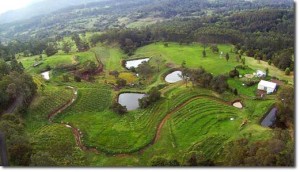At a recent NYC Green Drinks – Spark Speaker Series event, I was opened up to the world of permaculture by Andrew Faust. Andrew is a permaculture guru and the co-founder of the Center for BioRegional Living where he teaches Permaculture Design. In our ever growing environmentally conscious world, permaculture is a word I have heard pop up more and more in conversations, and perhaps you have too. It’s the current buzz word for sustainability designers. The equivalent for clean energy advocates is renewable energy.
So what is permaculture and what does it mean in a bioregional sense? Well, according to Andrew Faust, permaculture is a design process that seeks to ethically meet humanity’s needs by considering the ecological, geographical, topographical and sustainable characteristics of our surrounding environment. The idea is that by applying permaculture principles to what we do, from how we design and operate residential buildings to what crops to farm, the result will be responsible, just and beneficial in light of our confluent relationship with the earth.
In a bioregional sense, it means taking a macro look at our environment and shaping the choices we make by considering regions not defined by state or election lines, but defined by their biological and ecological characteristics – the presence of shale instead of limestone, sandy soil instead of clay, swamp or marshland, annual rainfall statistics, a migratory bird path or known breeding ground for fish. By shifting our thinking and adapting designs to incorporate and capitalize on the features of our environment, rather than imposing our designs and desires on it, we can function productively and harmoniously with our surroudings.
For the rural farmer in an arid climate, this might mean not growing cotton which is a water intensive crop. For the urban farmer seeking to beautify a balcony space, this might mean planting flower varieties to attract native pollinating bees which will bump up bee numbers and give them sustenance on their migration path north.
The permaculture design process can equally be employed to find ethical, ethnological and ecological solutions to existing problems. Did you know that over 60% of waste trucked out of New York City to landfills is organic, biodegradable matter? To do your part in reducing landfill, watch out for my upcoming article on composting to learn how to turn your kitchen scraps into vital nourishment for your plants.
Andrew Faust not only teaches permaculture, but designs systems for sustainable living all over the country. To learn more about the Center for BioRegional Living and see some of Andrew’s innovative permaculture design maps and plans, go to http://homebiome.com and to learn more about permaculture, go to http://permacultureprinciples.com.



